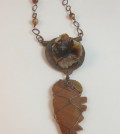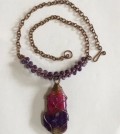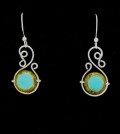- NEW DVD Series – Stone Setting with Bezels
- Tube Set Charm by Kim St. Jean
- Prong Basket Pendant by Kim St. Jean
- NEW DVD Series – Stone Setting with Cold Connections
- New DVD Series – Stone Setting with Wire
- NEW DVD Series: Introduction to Stone Setting by Kim St. Jean
- Featured Tool: Bracelet Bending Plier
- NEW Dvd by Eva Sherman
- Fun, Fast Fold Forming DVD Series
- Double Band Ear Cuff from Alex Simkin
Jewelry Making Resource July 18: Green Verdigris Recipe
by Rose Marion, Wire-Sculpture.com
With alternative metals like copper and bronze becoming more and more popular, it’s only natural to notice how much the colors change over time! While some of us try to resist the tarnish with products like Renaissance Wax, ProtectaClear, or simply lots of tarnish cloths, others embrace the colorful effects of time.
Most of us know about Liver of Sulfur, which will give copper and silver a beautiful blackened effect, which you can brush off with steel wool for an antique effect. But there are certainly other ways to get a patina on metal, and in different colors! Here’s a neat video I found which explains how to give copper a green verdigris patina:
Video by Brynmorgen Press
What a neat idea, I’m putting it on my “To-Try” list! How about you: do you use patinas on your jewelry – Liver or Sulfur, or do you know some good “recipes” like this video showed? Let us know in the comments below!
Click to Receive Daily Tips by Email




















spiderwoman
July 18, 2012 at 7:17 am
great idea, I love when I can make things from products I have at home instead of paying the high prices from jewelry making catalogs.
does everyone know they can darken silver by putting half a hard boiled egg in a jar and suspending their jewelry above it. be careful, it works fast.
Studycat
July 21, 2012 at 11:51 am
The hard boiled egg makes sense as it also contains sulphur. I’m going to have to try it!
Susan Lindsey
July 18, 2012 at 9:47 am
I got nice coloring on copper with a small torch – heat gives a lot of interesting colors. Until I used too much heat and just got black. This is one of those techniques where less is more.
Sue
Teresa
August 10, 2012 at 11:55 am
Sue, I have also used my little torch to add beautiful colors to copper. If it goes black, you can throw them in a pickling solution and it will take pretty much all the color off and you can start again. Pickling solution is made with a product named Sparex and it’s mixed with water and put in a little mini-crock pot as it works better if it’s quite warm. I just keep my solution in the little pot and warm it up when I think I’ll need it.
Jan
July 18, 2012 at 10:40 am
Nice tip–I’m anxious to try it. I love the verdigris finish. Thanks for providing it.
Laura
July 18, 2012 at 11:09 am
I’ve found that Clorox Mildew Root Remover works well. I lay the piece on a pad of paper towels inside a container, spray on the Mildew remover, and place the lid on securely. Then I sit it on my porch to bake in the sun. Provides a nice green patina on copper.
Alternatively, straight ammonia on the piece (laying on a paper towel pad in a plastic container) then sprinkled with sea salt produces a sapphire blue patina on copper. The longer you leave it the more dramatic the patina. It will dissolve iron-based plated beads if you leave it in for too long.
You have to be careful with chemicals, though. Mixing bleach (root remover) and ammonia can create deadly Chlorine gas.
Rose
July 19, 2012 at 9:00 am
Great ideas, Laura! I will have to try that ammonia and sea salt treatment, thanks!
Linda Kropp
July 18, 2012 at 12:25 pm
This is very interesting–I didn’t know that vinegar and ammonia together would work. I just love the look of verdegris. I’m wondering how people apply this kind of treatment to copper and bronze beads and wire and how long it takes to work. I would also like to know what people prefer to use to seal the patina so that it doesn’t rub off while the jewelry is being worn.
Jeannette Adams
July 19, 2012 at 6:16 am
HOW CAN WE GET ALL THE INFO TO ORDER THE ITEMS NEED TO TRY THIS? IF IT WAS THERE, I MISSED IT. THANKS. JEANNETTE
Rose
July 19, 2012 at 8:59 am
Hi Jeanette, as the video said, all you need is ammonia and vinegar (and probably an open window for ventilation!) Let us know how it works for you!
Urban Jule
July 20, 2012 at 4:30 am
I use the ammonia and salt recipe that Laura mentioned only I use Kosher salt, just because the large grains seem to speed up the process. I also wrap the piece in a paper towel, put the ammonia in a sealable container, put the wrapped piece directly into the ammonia (you don’t need much ammonia), seal the container with a lid and let sit for a couple of days. What I get is a nice blue patina with the added benefit that the creases in the paper towel makes some interesting textured effects on the copper. Often the color on one piece varies from blue green to blue to almost black on the same piece, giving it even further texture and depth
Pingback: How to Antique Wire Jewelry | Jewelry Making Blog | Information | Education | Videos
Teresa
August 10, 2012 at 11:58 am
I am wondering how long the process described in the video takes. It doesn’t appear to be an instant coloring.
Peggy Powers
October 6, 2012 at 12:07 pm
The sawdust idea sounds easy. However, I still want to know what else you do with the vinegar/ammonia mixture? What about finished jewelry? Great video, but needs more info. Please!!!
batu doko bacan
April 5, 2015 at 11:31 am
Molten Silica spit flies beyond an old rhyolite crater and flies into volcanic ash
(silica powder) and rolls down hill to round it.
Usually, natural pearl provides four numerous shades, red, white, yellow and deep black.
Cut and polished, these pieces potentially have for being worth a large
number of dollars.